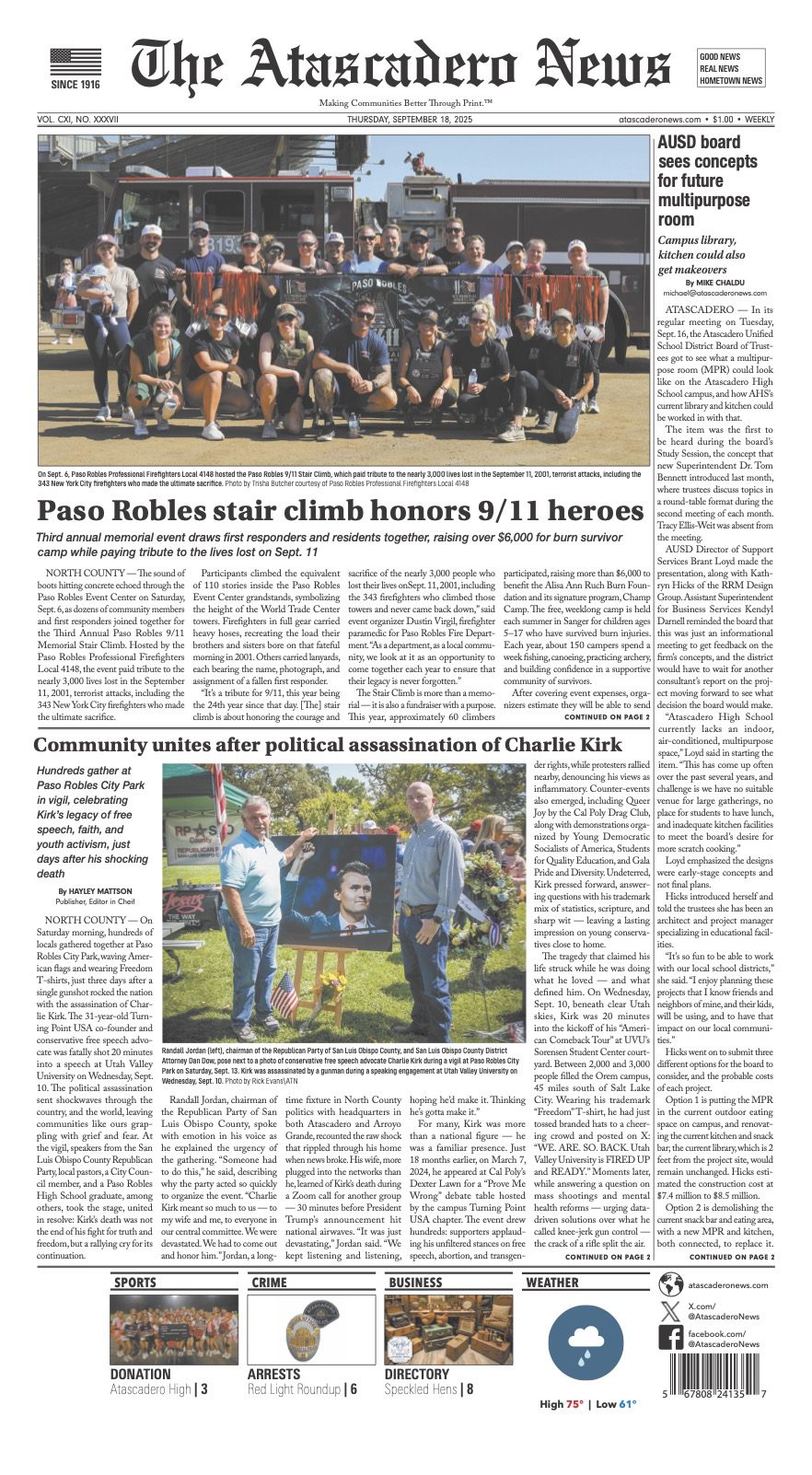Atascadero Chief of Police, Jerel Haley, released the following information on June 8, 2020, in response to police reform
The men and women of the Atascadero Police Department are governed by a guiding set of principles. These doctrines are codified for the members of our department in the Atascadero Police Department Policy Manual. The manual was developed with an understanding that “doing good” is our highest calling. What is stated so simply has a much deeper and more personal meaning to our officers. They understand that service, beyond self, in pursuit of the greater good for all residents is our purpose. Each officer takes an oath to provide this type of service prior to being able to wear our badge of office. We strive to do so in a manner that demonstrates the high value we place on human life, and preserves the dignity of all those with whom we come in contact.
The Atascadero Police Department is deeply committed to providing professional service to every member of our community and is constantly seeking ways to improve the training our officers receive to ensure the level of service we provide is in keeping with state law, recent court decisions, accepted practice and community expectations. Recently the City of Atascadero and the Atascadero Police Department became aware of a campaign developed by Campaign Zero related to police use of force, known as “8 Can’t Wait.” The Department’s current policies are in keeping with many or all of the provisions of that initiative. Below are some of the policies currently employed by the Atascadero Police Department that align with those eight pillars.
- Ban Chokeholds and Strangleholds – The Atascadero Police Department does not allow the use of “chokeholds” or “strangleholds.” While rarely used, properly trained officers may use the carotid restraint subject to the restrictions set forth in our policy. This policy can be found in section 300.3.4 of the Atascadero Police Department Policy manual. Governor Newsome has recently restricted the California Commission on Police Officer Standards and Training (POST) from providing training in the use of the carotid restraint.
- Require De-escalation – De-escalation has been incorporated in the policies and practices of our department for several years. De-escalation training is required as part of the POST Perishable Skills training that our officers receive every two years. In addition to the Perishable Skills course, our officers receive de-escalation instruction as part of other ongoing training including in the use of force, firearms, and response to mental health crisis incidents. Policies 300.3.1, 308.9, 418.4(c), 466.5(b), 466.6 and 467.3(c) are some of the examples of language related to this issue and are indicative of the direction and training provided to our officers.
- Require warning before shooting – The Atascadero Police Department requires that warnings be issued before the use of force in some instances such as in the use of Kinetic Energy devised such as the Taser (Policy 308.9.2). Deadly force is restricted to instances that require immediate action based on the totality of the circumstances under Policy 300.4(a), and officers are required to give warnings prior to the use of deadly force when possible Policy 300.4(b).
- Exhaust all other means before shooting – Policy 300.4 requires officers to evaluate other reasonable uses of force prior to making the decision to use deadly force. Additionally, Officers shall not use deadly force against a person based on the danger that person poses to him/herself, if an objectively reasonable officer would believe the person does not pose an imminent threat of death or serious bodily injury to the officer or to another person (Penal Code § 835a).
- Duty to intervene – Policy 300.2.1 requires our officers to intervene in those instances in which they observe another officers using unreasonable force. The use of unreasonable force must also be reported immediately to a supervisor.
- Ban shooting at moving vehicles – Shooting at moving vehicles is rarely effective and officers are generally discouraged from this practice. Officers are encouraged to use other methods to eliminate threats posed from moving vehicles prior to the use of force, such as moving out of the path of the moving vehicle. Officers are also restricted in the use of firearms to disable a vehicle. All of these provisions are part of our policy under section 300.4.1.
- Require use of force continuum – The concept of a use of force continuum is largely outdated and has been replaced by a more knowledgeable and science-based approach to the use of force. Our agency has adopted a comprehensive approach to the use of force by our officers that can be found in Policy 300. Additional direction to our officers is given in many other parts of our policy. Sections 306, 308, 309, and 312 are some examples. Officers also receive ongoing training in the use of force, specifically in the application of deadly force.
- Require comprehensive reporting – Officers are required to thoroughly and accurately document any use of force incident. Officers should include in this reporting any of the factors that caused he/she to believe that the use of force was reasonable under the circumstances, Policy 300.5. In addition to the use of force, the Atascadero Police Department provides direction to our officers in the preparation of all other types of police reports as well. Examples of this direction can be found in policy 344.
The entire Policy Manual of the Atascadero Police Department can be found at atascadero.org/files/PD/PD_Policy_Manual.pdf.
















